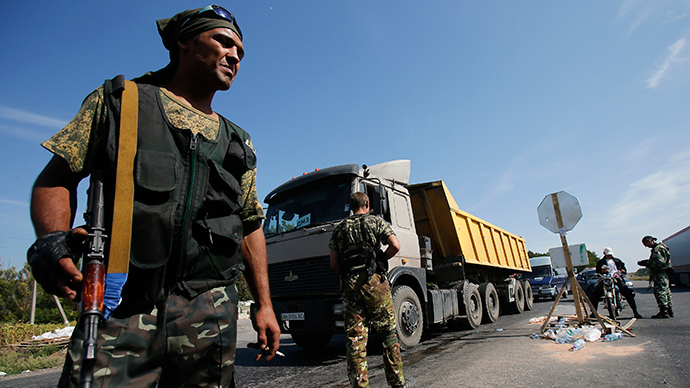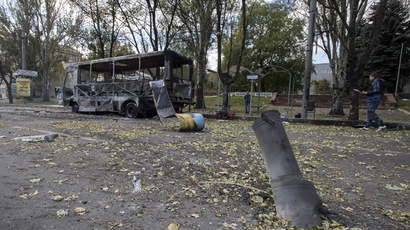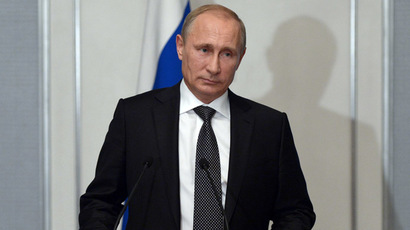Demilitarized zone, OSCE monitoring among E.Ukraine militias’ peace proposals

The self-proclaimed People's Republics of Donetsk and Lugansk have come up with their own proposals to stabilize the situation in south-eastern Ukraine, which include a temporary ceasefire, a demilitarized zone, flight bans for Kiev and OSCE monitoring.
The first and most important step should be the announcement of a
temporary ceasefire by both the Ukrainian military and the
self-defense forces starting from 15:00 local time (12:00GMT) on
September 5, the Donetsk and Lugansk representatives told
Interfax news agency.
The leadership of the two republics proposed to “carry out
international control of the implementation of the terms of the
ceasefire and monitoring of the situation under the authority of
the OSCE (Organization for Security and Co-operation in
Europe).”
According to the initiative, a security zone should be created in
the territory of Donetsk and Lugansk Republics, which will be
divided into five sectors, each hosting up to 40 observers
working at stationary and mobile offices.
The OSCE staff is to be equipped with means of surveillance and
communication to effectively execute their duties, the
representatives stressed.
The other proposals include a ban on all flights by Ukrainian
military aircraft over the territory of the People's Republics of
Donetsk and Lugansk, also starting from 15:00 local time
(12:00GMT) on September 5.
It’s proposed that the implementation will also be monitored by
the OSCE, which will receive data directly from Russia’s
objective airspace situation control.
The humanitarian corridors for relocation refugees and delivery
of humanitarian supplies to the cities in Donetsk and Lugansk
Republics via road and railway are to be opened from 10:00 local
time (07:00GMT) on September 7, the representatives added.
The proposals will be presented to the Russia-Ukraine-EU contact
group on the settlement of the conflict, which is scheduled to
meet in Minsk, Belarus on Friday, the heads of the two
self-proclaimed republics said in a statement.
The initiatives coming from Donetsk and Lugansk only add
specifics to the 7-step peace plan for the settlement of the
conflict in Ukraine, which was voiced by Russian President,
Vladimir Putin, on Wednesday.
Read more: Ukraine ceasefire: Putin lays out 7-step plan to stop hostilities in E. Ukraine
It envisaged a halt to the militia’s advances in the Donetsk and Lugansk Regions; withdrawal of Kiev troops to a distance that makes shelling impossible; objective international control over the ceasefire; a ban on the use of combat aircraft against civilians; unconditional prisoner exchange; the organization of humanitarian corridors, and a provision of direct access for repair crews to destroyed infrastructure.

The security minister of the People's Republic of Donetsk, Leonid
Baranov, has also fully backed the Russian president’s idea of
prisoner exchange without preconditions via an “all-for-all”
formula.
“We’ll insist on the plan proposed by Vladimir Putin. It’s
difficult to predict what Kiev’s reaction would be. Personally, I
think that the most realistic solution is an ‘all-for-all’
exchange,” the minister told RIA-Novosti news agency after
arriving in Minsk.
Another unnamed representative of the Donetsk People’s Republic
told RIA-Novosti about the need to create a demilitarized zone at
the republic’s borders with Ukraine.
The ceasefire will actually work “only after the Ukrainian
troops will be withdrawn to the distance, from which they won’t
be able to use their long-range artillery – that’s around 50
kilometers from the Donetsk People’s Republic borders,” he
explained.
Earlier on Thursday, Ukraine’s President Petro Poroshenko said
that he’ll also order a ceasefire for government troops fighting
self-defense forces in the southeast of country if the meeting in
the Belarusian capital goes as planned.
Ukraine has been engulfed in violent internal conflict since
April, when Kiev’s military began its crackdown on the
southeastern regions of the country.
According to United Nations’ estimates released on Tuesday, over
2,249 people have been killed so far and more than 6,033 wounded
in the fighting in eastern Ukraine.
The number of internally displaced Ukrainians has reached
260,000, with another 814,000 finding refuge in Russia, the UN
said.














